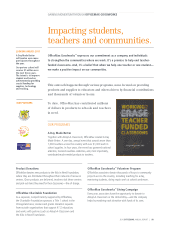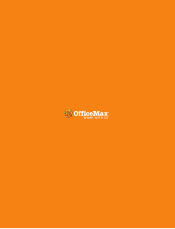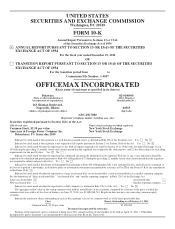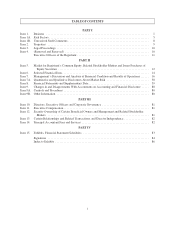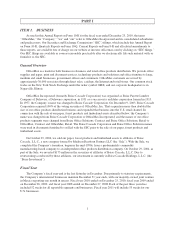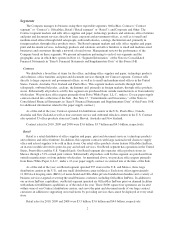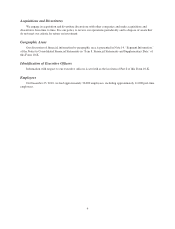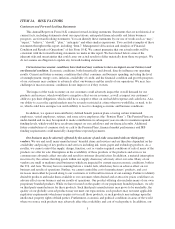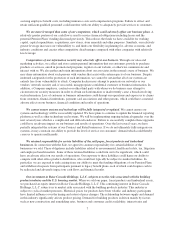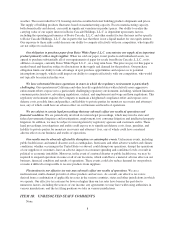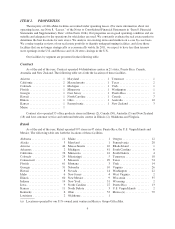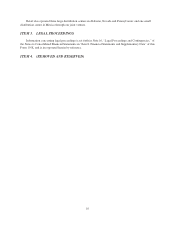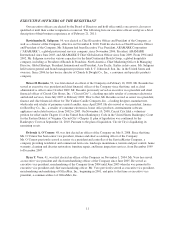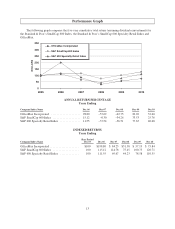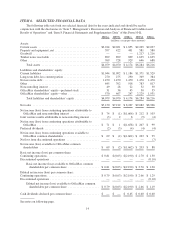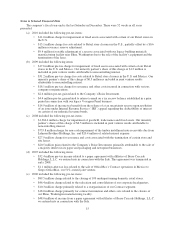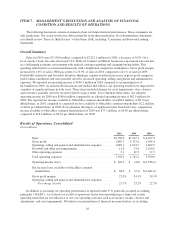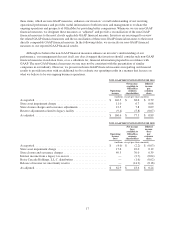OfficeMax 2010 Annual Report Download - page 27
Download and view the complete annual report
Please find page 27 of the 2010 OfficeMax annual report below. You can navigate through the pages in the report by either clicking on the pages listed below, or by using the keyword search tool below to find specific information within the annual report.as rising employee benefit costs, including insurance costs and compensation programs. Failure to attract and
retain sufficient qualified personnel could interfere with our ability to adequately provide services to customers.
We are more leveraged than some of our competitors, which could adversely affect our business plans. A
relatively greater portion of our cash flow is used to service financial obligations including leases and the
potential Pension Plans’ funding discussed previously. This reduces the funds we have available for working
capital, capital expenditures, acquisitions, new stores, store remodels and other purposes. Similarly, our relatively
greater leverage increases our vulnerability to, and limits our flexibility in planning for, adverse economic and
industry conditions and creates other competitive disadvantages compared with other companies with relatively
less leverage.
Compromises of our information security may adversely affect our business. Through our sales and
marketing activities, we collect and store certain personal information that our customers provide to purchase
products or services, enroll in promotional programs, register on our website, or otherwise communicate and
interact with us. We also gather and retain information about our associates in the normal course of business. We
may share information about such persons with vendors that assist with certain aspects of our business. Despite
instituted safeguards for the protection of such information, we cannot be certain that all of our systems are
entirely free from vulnerability to attack. Computer hackers may attempt to penetrate our networks or our
vendors’ network security and, if successful, misappropriate confidential customer or business information. In
addition, a Company employee, contractor or other third party with whom we do business may attempt to
circumvent our security measures in order to obtain such information or inadvertently cause a breach involving
such information. Loss of customer or business information could disrupt our operations and expose us to claims
from customers, financial institutions, payment card associations and other persons, which could have a material
adverse effect on our business, financial condition and results of operations.
We cannot ensure systems and technology will be fully integrated or updated. We cannot ensure our
systems and technology will be successfully updated. We have plans to continue to update the financial reporting
platform as well as other technology and systems. We will be implementing ongoing technical upgrades over the
next several years which is a complicated and difficult endeavor. Failure to successfully complete these upgrades
could have an adverse impact on our business and results of operations. Over the last several years, we have
partially integrated the systems of our Contract and Retail businesses. If we do not ultimately fully integrate our
systems, it may constrain our ability to provide the level of service our customers’ demand which could thereby
cause us to operate inefficiently.
We retained responsibility for certain liabilities of the sold paper, forest products and timberland
businesses. In connection with the Sale, we agreed to assume responsibility for certain liabilities of the
businesses we sold. These obligations include liabilities related to environmental, health and safety, tax, litigation
and employee benefit matters. Some of these retained liabilities could turn out to be significant, which could
have an adverse effect on our results of operations. Our exposure to these liabilities could harm our ability to
compete with other office products distributors, who would not typically be subject to similar liabilities. In
particular, we are exposed to risks arising from our ability to meet the funding obligations of our Pension Plans
and withdrawal requests from participants pursuant to legacy benefit plans, each of which could require cash to
be redirected and adversely impact our cash flows and financial results.
Our investment in Boise Cascade Holdings, L.L.C. subjects us to the risks associated with the building
products industry and the U.S. housing market. When we sold our paper, forest products and timberland assets,
we purchased an equity interest in Boise Cascade Holdings, L.L.C. This continuing interest in Boise Cascade
Holdings, L.L.C. subjects us to market risks associated with the building products industry. This industry is
subject to cyclical market pressures. Historical prices for products have been volatile, and industry participants
have limited influence over the timing and extent of price changes. The relationship between supply and demand
in this industry significantly affects product pricing. Demand for building products is driven mainly by factors
such as new construction and remodeling rates, business and consumer credit availability, interest rates and
7


